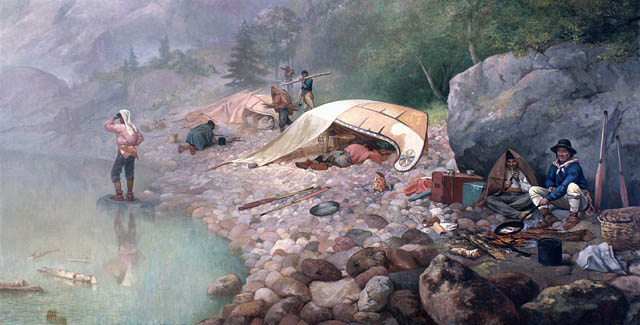Macleans
Copper-trading Scandal
Executives are nervously punching new numbers into their calculators at the headquarters of Gibraltar Mines Ltd. in Williams Lake, B.C.This article was originally published in Maclean's Magazine on July 1, 1996

Enter your search term
Signing up enhances your TCE experience with the ability to save items to your personal reading list, and access the interactive map.
Create AccountMacleans
Executives are nervously punching new numbers into their calculators at the headquarters of Gibraltar Mines Ltd. in Williams Lake, B.C.This article was originally published in Maclean's Magazine on July 1, 1996
"https://www.thecanadianencyclopedia.ca/images/tce_placeholder.jpg?v=e9dca980c9bdb3aa11e832e7ea94f5d9" // resources/views/front/categories/view.blade.phphttps://www.thecanadianencyclopedia.ca/images/tce_placeholder.jpg?v=e9dca980c9bdb3aa11e832e7ea94f5d9

Article
Copyright ProperCopyright. The legal protection given to creators of literary, musical, and artistic works.
"https://www.thecanadianencyclopedia.ca/images/tce_placeholder.jpg?v=e9dca980c9bdb3aa11e832e7ea94f5d9" // resources/views/front/categories/view.blade.phphttps://www.thecanadianencyclopedia.ca/images/tce_placeholder.jpg?v=e9dca980c9bdb3aa11e832e7ea94f5d9

Article
Corel Corporation is a world leader in the development of graphics and multimedia software. Founded in June 1985 by Michael COWPLAND, the company is now Canada's largest software developer and ranks second to Microsoft for application software companies worldwide.
"https://www.thecanadianencyclopedia.ca/images/tce_placeholder.jpg?v=e9dca980c9bdb3aa11e832e7ea94f5d9" // resources/views/front/categories/view.blade.phphttps://www.thecanadianencyclopedia.ca/images/tce_placeholder.jpg?v=e9dca980c9bdb3aa11e832e7ea94f5d9

Article
Corn laws, 1794-1846, set duties on grain imports into Britain to protect British agriculture from outside competition. (In Britain, "corn" is the name for CEREAL CROPS.
"https://www.thecanadianencyclopedia.ca/images/tce_placeholder.jpg?v=e9dca980c9bdb3aa11e832e7ea94f5d9" // resources/views/front/categories/view.blade.phphttps://www.thecanadianencyclopedia.ca/images/tce_placeholder.jpg?v=e9dca980c9bdb3aa11e832e7ea94f5d9

Macleans
SOME COUNTERFEIT MONEY is easy to spot. A veteran RCMP officer recalls once seeing a particularly lame bill photocopied in black and white, then coloured in with crayons.This article was originally published in Maclean's Magazine on January 20, 2003
"https://www.thecanadianencyclopedia.ca/images/tce_placeholder.jpg?v=e9dca980c9bdb3aa11e832e7ea94f5d9" // resources/views/front/categories/view.blade.phphttps://www.thecanadianencyclopedia.ca/images/tce_placeholder.jpg?v=e9dca980c9bdb3aa11e832e7ea94f5d9

"https://www.thecanadianencyclopedia.ca/images/tce_placeholder.jpg?v=e9dca980c9bdb3aa11e832e7ea94f5d9" // resources/views/front/categories/view.blade.phphttps://www.thecanadianencyclopedia.ca/images/tce_placeholder.jpg?v=e9dca980c9bdb3aa11e832e7ea94f5d9

Article
Coureurs des bois were itinerant, unlicenced fur traders from New France. They were known as “wood-runners” to the English on Hudson Bay and “bush-lopers” to the Anglo-Dutch of New York. Unlike voyageurs, who were licensed to transport goods to trading posts, coureurs des bois were considered outlaws of sorts because they did not have permits from colonial authorities. The independent coureurs des bois played an important role in the European exploration of the continent. They were also vital in establishing trading contacts with Indigenous peoples.
"https://d3d0lqu00lnqvz.cloudfront.net/media/media/2a01defb-42f2-4ad3-b7f1-cf7966378002.jpg" // resources/views/front/categories/view.blade.phphttps://d3d0lqu00lnqvz.cloudfront.net/media/media/2a01defb-42f2-4ad3-b7f1-cf7966378002.jpg

Macleans
This article was originally published in Maclean’s magazine on December 4, 1995. Partner content is not updated. Ever since the first CP train pulled out of Montreal on June 28, 1886, bound for the new province of British Columbia, Canadian Pacific has played a dominant role in the nation's corporate mythology. And so last week, when CP Ltd.
"https://www.thecanadianencyclopedia.ca/images/tce_placeholder.jpg?v=e9dca980c9bdb3aa11e832e7ea94f5d9" // resources/views/front/categories/view.blade.phphttps://www.thecanadianencyclopedia.ca/images/tce_placeholder.jpg?v=e9dca980c9bdb3aa11e832e7ea94f5d9

Article
Prior to the First World War, Canada boasted 117 independent breweries. But by the early 1980s, just 10 brewing companies remained in Canada — and the three largest, Molson, Labatt and Carling O’Keefe — owned 96 per cent of the market.
"https://d3d0lqu00lnqvz.cloudfront.net/media/media/0aa05c31-5e3e-4f8c-9dee-01ed19c06a92.jpg" // resources/views/front/categories/view.blade.phphttps://d3d0lqu00lnqvz.cloudfront.net/media/media/0aa05c31-5e3e-4f8c-9dee-01ed19c06a92.jpg

Article
Craft unionism, a form of labour organization developed to promote and defend the interests of skilled workers (variously known as artisans, mechanics, craftsmen and tradesmen).
"https://thecanadianencyclopedia.ca/images/tce_placeholder.jpg?v=e9dca980c9bdb3aa11e832e7ea94f5d9" // resources/views/front/categories/view.blade.phphttps://thecanadianencyclopedia.ca/images/tce_placeholder.jpg?v=e9dca980c9bdb3aa11e832e7ea94f5d9

Article
Credit Bureaus provide a credit profile of consumers based on their repayment record of outstanding debts. A credit bureau monitors, with constantly updated information provided by credit card and other lenders, not only whether consumers repay loans but whether they do so regularly and on time.
"https://www.thecanadianencyclopedia.ca/images/tce_placeholder.jpg?v=e9dca980c9bdb3aa11e832e7ea94f5d9" // resources/views/front/categories/view.blade.phphttps://www.thecanadianencyclopedia.ca/images/tce_placeholder.jpg?v=e9dca980c9bdb3aa11e832e7ea94f5d9

Article
A credit card is a card authorizing the holder to make purchases on credit. Credit cards are issued by financial institutions and non-financial businesses (eg, department stores, gasoline companies).
"https://www.thecanadianencyclopedia.ca/images/tce_placeholder.jpg?v=e9dca980c9bdb3aa11e832e7ea94f5d9" // resources/views/front/categories/view.blade.phphttps://www.thecanadianencyclopedia.ca/images/tce_placeholder.jpg?v=e9dca980c9bdb3aa11e832e7ea94f5d9

Article
Credit Unions, financial co-operatives that provide deposit, chequing and lending services to the member owners. Owned locally and operated under provincial jurisdiction, they jointly own provincial central organizations.
"https://www.thecanadianencyclopedia.ca/images/tce_placeholder.jpg?v=e9dca980c9bdb3aa11e832e7ea94f5d9" // resources/views/front/categories/view.blade.phphttps://www.thecanadianencyclopedia.ca/images/tce_placeholder.jpg?v=e9dca980c9bdb3aa11e832e7ea94f5d9

Article
Crop Insurance An all-risk crop-insurance program is available to Canadian farmers under the authority of the federal Crop Insurance Act (of 1959) and through concurrent and complementary legislation enacted by each province.
"https://www.thecanadianencyclopedia.ca/images/tce_placeholder.jpg?v=e9dca980c9bdb3aa11e832e7ea94f5d9" // resources/views/front/categories/view.blade.phphttps://www.thecanadianencyclopedia.ca/images/tce_placeholder.jpg?v=e9dca980c9bdb3aa11e832e7ea94f5d9

Article
Crown corporations are wholly owned federal or provincial organizations that are structured like private or independent companies. They include enterprises such as the Canadian Broadcasting Corporation (CBC), VIA Rail, Canada Post and the Bank of Canada; as well as various provincial electric utilities. Crown corporations have greater freedom from direct political control than government departments. As long as crown corporations have existed, there has been debate about their structure, accountability and role in the economy.
"https://d3d0lqu00lnqvz.cloudfront.net/media/new_article_images/HockeyNightInCanada/626px-CBC_logo_1940–1958.png" // resources/views/front/categories/view.blade.phphttps://d3d0lqu00lnqvz.cloudfront.net/media/new_article_images/HockeyNightInCanada/626px-CBC_logo_1940–1958.png
